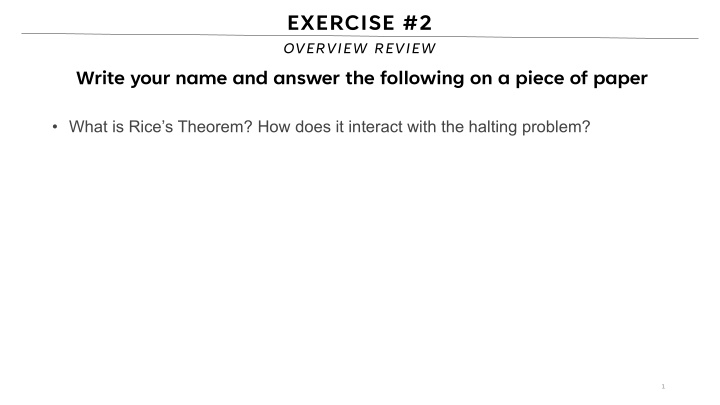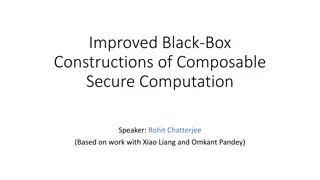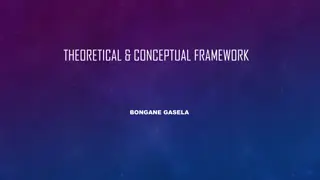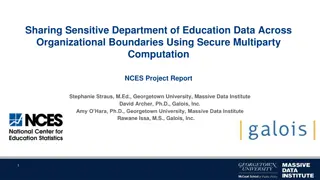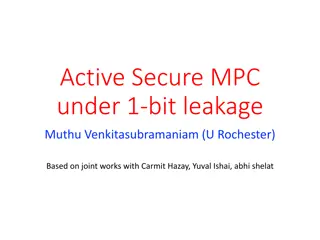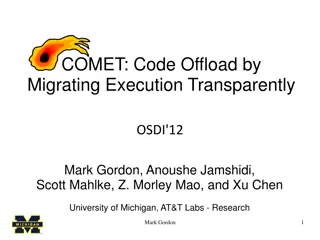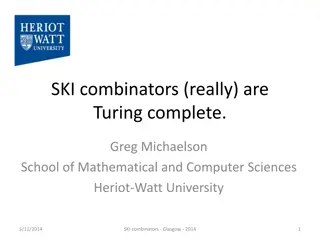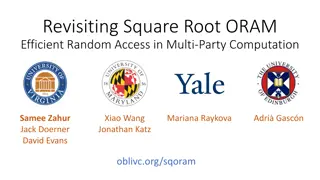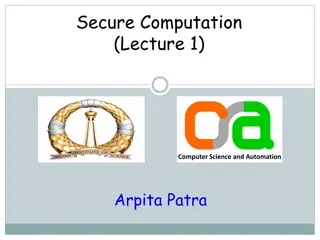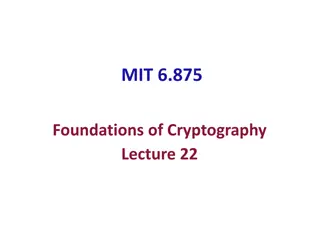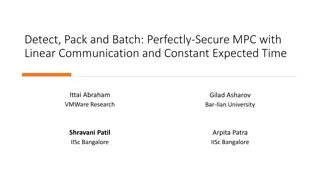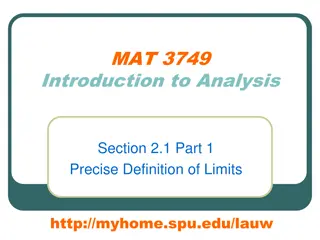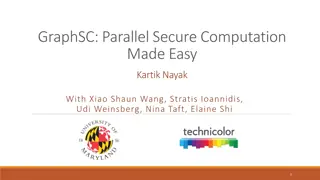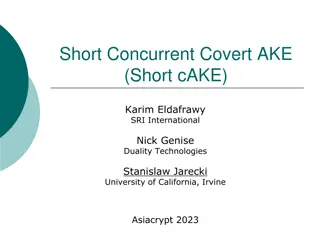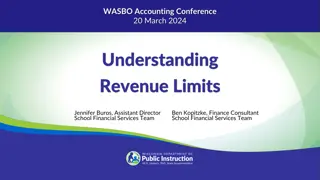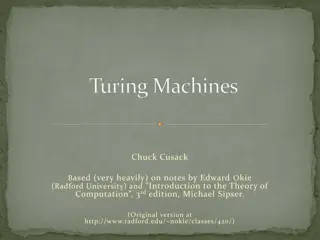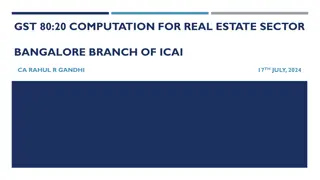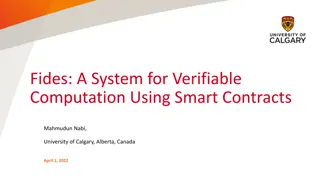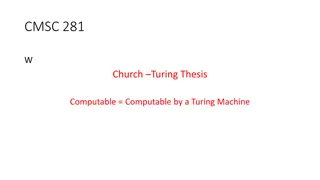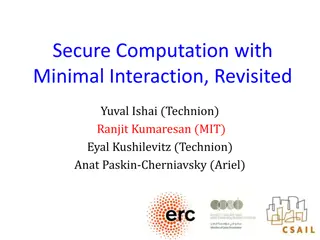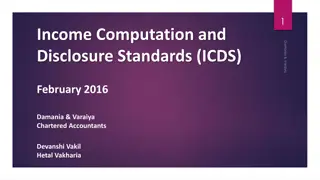Computability: Exploring Theoretical Limits of Computation
Delve into computability theory, focusing on what is computable and the limits of computation. Explore concepts like Rice's Theorem, the Halting Problem, and classes of expressiveness in computability theory, such as combinational logic, finite-state machines, pushdown automata, and Turing machines.
Download Presentation

Please find below an Image/Link to download the presentation.
The content on the website is provided AS IS for your information and personal use only. It may not be sold, licensed, or shared on other websites without obtaining consent from the author.If you encounter any issues during the download, it is possible that the publisher has removed the file from their server.
You are allowed to download the files provided on this website for personal or commercial use, subject to the condition that they are used lawfully. All files are the property of their respective owners.
The content on the website is provided AS IS for your information and personal use only. It may not be sold, licensed, or shared on other websites without obtaining consent from the author.
E N D
Presentation Transcript
EXERCISE #2 OVERVIEW REVIEW Write your name and answer the following on a piece of paper What is Rice s Theorem? How does it interact with the halting problem? 1
COMPUTABILITY EECS 677: Software Security Evaluation Drew Davidson
ADMINISTRIVIA AND ANNOUNCEMENTS
4 THE HALTING PROBLEM GIVEN AN ARBITRARY COMPUTER PROGRAM AND AN INPUT, DETERMINE WHETHER THE PROGRAM WILL FINISH RUNNING, OR CONTINUE TO RUN FOREVER
TODAYS ROADMAP Decidability The Halting Problem Type I/Type II Errors Soundness / Completeness
6 THE LIMITS OF COMPUTATION DECIDABILITY Computers! What can t they do?! As we begin our exploration of security evaluation, we care about this question for two reasons: We need to know the capabilities of our analysis target We need to know the capabilities of our analysis engine
7 THEORETICAL LIMITS OF COMPUTATION DECIDABILITY Computability theory The study of what is computable Focused on abstractions for the sake of generalizability Considers theoretical hardware, for example
8 COMPUTATIONAL POWER DECIDABILITY What is a program? A set of executable instructions
9 COMPUTATIONAL POWER DECIDABILITY What is a program? A set of executable instructions There are many formats for programs i.e. programming languages It would be nice to generalize what these programs can compute (without getting bogged down in syntax)
10 ABSTRACTING COMPUTATION DECIDABILITY Computability theory considers classes of expressiveness Combinational logic Finite-state machines Pushdown automata Turing machines
11 ABSTRACTING COMPUTATION DECIDABILITY Computability theory considers classes of expressiveness Combinational logic Finite-state machines Pushdown automata Turing machines
12 ABSTRACTING COMPUTATION DECIDABILITY Computability theory considers classes of expressiveness Combinational logic Finite-state machines Pushdown automata Turing machines
13 ABSTRACTING COMPUTATION DECIDABILITY Computability theory considers classes of expressiveness Combinational logic Finite-state machines Pushdown automata Turing machines
14 CHURCH-TURING THESIS DECIDABILITY Roughly: a function on the natural numbers can be calculated if and only if it is computable by a Turing machine Practical Upshot: Turing machines are powerful! Turing Machine
15 VIBE CHECK DECIDABILITY Does everyone remember why we are doing this? We want to determine the power of our analysis target We want to determine the power of our analysis engine Good news! Both are bounded by Turing computability Next up: abstracting analysis itself
16 DECISION PROCEDURES DECIDABILITY A little vocabulary: A decision problem is a computational question that can be solved with either a yes or a no. Frequently, we consider decision problems as detection of a property in a program A decision procedure is a method for solving a decision problem that always yields the correct answer If there is no decision procedure for a given decision problem, that decision problem is called undecidable
17 PROGRAM ANALYSIS AS DECISION PROCEDURE DECIDABILITY Since a program is just a list of instructions, it is valid input to a decision procedure Analysis Target (arbitrary program) Analysis Engine (property detector program) Yes No (property present) (property is not present)
18 STRONG GUARANTEES DECIDABILITY A decision procedure is a high bar Analysis Target (arbitrary program) Guarantee that: The analysis engine accepts every program The analysis engine always returns an answer The answer returned is always correct Analysis Engine (property detector program) Rice s Theorem Yes No (property present) (property is not present)
TODAYS ROADMAP Decidability The Halting Problem Type I/Type II Errors Soundness / Completeness
20 STATING THE PROBLEM THE HALTING PROBLEM Given a description of a Turing machine and its initial input, determine whether the program, when executed on this input, ever halts (completes). The alternative is that it runs forever without halting
21 A HALTING DETECTOR THE HALTING PROBLEM Analysis Target + Input (arbitrary program) Given a description of a Turing machine and its initial input, determine whether the program, when executed on this input, ever halts (completes). The alternative is that it runs forever without halting Halting Detector Is there a decision procedure for the halting problem? - We ll sketch the proof outline that there is NOT - Relies on a proof by contradiction Yes No (target halts) (target spins)
22 PROOF BY CONTRADICTION THE HALTING PROBLEM Reductio ad absurdum Assuming the premise has obviously incorrect consequences Here: assume there is a halting detector Assumption Black_magic Black_magic Halting Detector black_magic(){ if (halts(black_magic){ while(true){} //Spin } //Halt } Halting Detector Yes No (target halts) (target spins) black_magic halts Black_magic spins spin halt halts(ANY ARBITRARY PROGRAM)
23 WHO CARES? THE HALTING PROBLEM No halting decision procedure means no reachability decision procedure 1. int main(){ 2. if (my_function()){ 3. int * a = nullptr; 4. *a = 1; 5. } 6. } This program crashes if and only if it reaches line 4, which depends on the result of a function call being true black_magic()
24 RICE S THEOREM THE HALTING PROBLEM No halting decision procedure means no reachability decision procedure Exhibits the behavior you care about 1. int main(){ 2. if (my_function()){ 3. int * a = nullptr; 4. *a = 1; 5. } 6. } This program crashes if and only if it reaches line 4, which depends on the result of a function call being true black_magic() behavior you care about
25 RICE S THEOREM THE HALTING PROBLEM All non-trivial semantic properties of programs are undecidable
26 LIMITATIONS OF RICE S THEOREM THE HALTING PROBLEM Rice s Theorem is less catastrophic than you might expect for security: A decision procedure is a pretty high bar A Turing machine is actually not a perfect approximation of the computers we use! Despite these limitations, it is widely accepted that program analysis is always approximate We can t be right all of the time We can choose what types of errors we make
TODAYS ROADMAP Decidability The Halting Problem Categorizing Program Analyses Soundness / Completeness
28 TYPES OF ANALYSIS CATEGORIZING PROGRAM ANALYSES In order to determine the properties of a given program analysis, let s frame it as a detector Analysis Target (arbitrary program) Note: we can detect bad behavior or good behavior Analysis Engine (property detector program) Yes No (property present) (property is not present)
29 CLASSIFYING ERRORS CATEGORIZING PROGRAM ANALYSES False Analysis is wrong True Analysis is correct Analysis Target (arbitrary program) Has report Has report Has bug No bug Positive report bug Type I Error Correct Analysis Engine (bug detector) No report No bug No report Has bug Negative No bug report Type II Error No Correct Yes (property is not present) (buggy)
TODAYS ROADMAP Decidability The Halting Problem Categorizing Program Analyses Soundness / Completeness
31 GUARANTEES OF IMPERFECT ANALYSES SOUNDNESS / COMPLETENESS Consistency / Reliability super important for users We d like to limit the kinds of errors we report We can choose which type of bug report error to avoid Soundness: No false positives Completeness: No false negatives
32 VISUAL ANALOGY SOUNDNESS / COMPLETENESS Reported bugs Imagine the universe of all programs is contained in a circle You can draw a circle around the programs you report as buggy The actual buggy programs occupy a jagged region All Programs Buggy programs
33 VISUAL ANALOGY SOUNDNESS / COMPLETENESS Reported bugs Reported bugs All Programs All Programs False Positive Buggy programs Buggy programs False Negative Sound bug detection All correct programs pass through (No false positive problem) Complete bug detection All buggy programs get flagged (No false negative problem) Some buggy programs pass through (has false negative problem) Some correct programs get flagged (has false positive problem)
34 TRIVIAL SOUNDNESS CATEGORIZING PROGRAM ANALYSES Reported bugs All Programs Analysis Target (arbitrary program) Buggy programs Analysis Engine (bug detector) False Negative No (property is not present) Sound bug detection All correct programs pass through (No false positive problem) Some buggy programs pass through (has false negative problem)
35 TRIVIAL COMPLETENESS CATEGORIZING PROGRAM ANALYSES Reported bugs All Programs Analysis Target (arbitrary program) False Positive Buggy programs Analysis Engine (bug detector) Yes (buggy) Complete bug detection All buggy programs get flagged (No false negative problem) Some correct programs get flagged (has false positive problem)
36 BEYOND ALL-OR-NOTHING SOUNDNESS / COMPLETENESS As you can imagine, soundness and completeness are not the full story Guarantees are nice, but we want legitimately useful analyses! Many practical analyses are neither sound nor complete
37 STATIC VS DYNAMIC ANALYSIS SOUNDNESS / COMPLETENESS One distinction in analysis is how the analysis treats the target Static analysis Operates without running the program Dynamic analysis - Operates with running the program
38 ANALYSIS METHOD VS ERRORS SOUNDNESS / COMPLETENESS It s natural to consider the types of compromises of each analysis method Static analysis Often builds a model of the program, makes inferences on that model Tends to make completeness easier Scalability concerns for large programs Dynamic analysis Often performs the analysis by straight up running the program, observing behavior Tends to make soundness easier Coverage problems
39 ABOUT COVERAGE SOUNDNESS / COMPLETENESS int f(bool b) { Obj * o = null; int v = 2; if (b) { o = new Obj (); v = rand_int(); } if (v == 2){ o->setInvalid() } return o->property(); } Line coverage Branch coverage Path coverage
LECTURE END Summary: - Decidability - Computational Theory - Categorizing analysis
